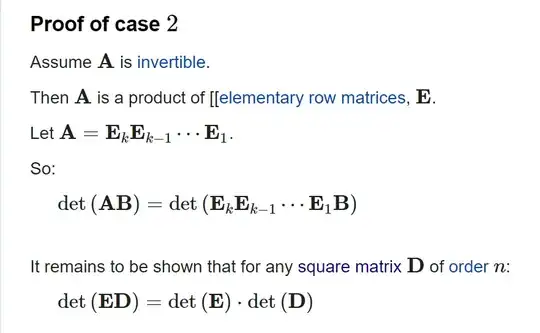Is there a easy proof for $\det(EA)=\det(E)\det(A)$, where E is an elementary matrix? Determinant here is defined through cofactor expansion.
I checked Proof $\det(AB)=\det(A)\det(B)$ and one answer there linked a wiki - https://proofwiki.org/wiki/Determinant_with_Row_Multiplied_by_Constant
In proof 1 section of the link, they put,  However, when I go to "Determinant of Matrix Product" - https://proofwiki.org/wiki/Determinant_of_Matrix_Product and try to see its proof, they put
However, when I go to "Determinant of Matrix Product" - https://proofwiki.org/wiki/Determinant_of_Matrix_Product and try to see its proof, they put and I don't see any proof for $\det(EA) = \det(E)\det(A)$, so it circles back to the question - Proof $\det(AB)=\det(A)\det(B)$.
I haven't learned about permutations, so I have trouble understanding the proof 1 section of the wiki link. I would be glad if you show me a proof for $\det(EA)=\det(E)\det(A)$ without permutations.
and I don't see any proof for $\det(EA) = \det(E)\det(A)$, so it circles back to the question - Proof $\det(AB)=\det(A)\det(B)$.
I haven't learned about permutations, so I have trouble understanding the proof 1 section of the wiki link. I would be glad if you show me a proof for $\det(EA)=\det(E)\det(A)$ without permutations.
My previous question was Is there any easy way to prove $\det(EA) = \det(E)\det(A)?$, where $E$ is an elementary matrix?. But I found that it was not a duplicated question-please check the comments-so I am asking the question again.
I checked Proof of determinants for matrices of any order, Proof $\det(AB)=\det(A)\det(B)$, and How to show that $\det(AB) =\det(A) \det(B)$?, but they don't explain what I want to know.